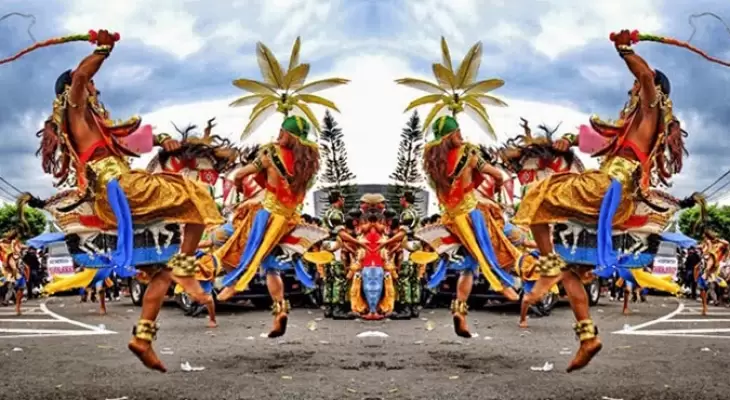Kuda Lumping: A Spirited, Glass-Eating Javanese Game of Horse

Holiday Ayo - A dark-skinned boy lifts his right leg over a horse made out of woven bamboo. He holds the horse’s head as though riding a real stallion. He looks up, then closes his eyes. In less than a minute, the boy’s head begins to shake. He then dances to traditional music blaring from a loudspeaker.
A band of tiny bells tied around his right ankle jingles every time he stomps his foot. He stops in front of a bucket, bends his body, and, just like a horse, drinks from it several times before moving again. As he pauses, a man with a long, thick whip strikes him. The man does it several times to make the boy — who now believes he is a horse — move.
The boy, Wahyu Sulaiman, is said to be in a trance. Although he gets whipped numerous times, he claims to feel no pain. A man leads him around to ask for money from onlookers.

A woman walking along with them holds out a flat bamboo basket with shards from broken light bulbs. As they stop in front of an onlooker who has thrown money into the basket, the woman puts pieces of broken glass into Wahyu’s mouth. The 12-year-old munches on the glass before swallowing the deadly meal.
The group is called Lestari Budaya (Cultural Preservation) and is responsible for the surreal performance at Taman Mini Indonesia Indah this Sunday. The kuda lumping (flat horse) performed by Wahyu, along with his parents, uncles, aunts, and cousins, is a traditional dance from Java.
There are various beliefs surrounding the origins of kuda lumping. Some believe that the dance is a depiction of the troops of Prince Diponegoro — a national hero known for his battle against the Dutch colonialists — riding horses. Another is that it portrays the Mataram troops in their fight against the Dutch in the 1800s.
There are many ways to perform the kuda lumping dance. Some performances involve a group of men dressed up like soldiers, while others, like the Lestari Budaya group, channel spirits to help the dancers achieve a trance-like state. The dance is widely performed in East Java and Yogyakarta during traditional ceremonies.
Lestari Budaya was formed in 1975 by Saliman and Kasmi, Wahyu’s grandparents and Ngadino’s in-laws. The couple was previously part of a kuda lumping group in their hometown, Surabaya. In 1970, however, they decided to seek greener pastures in Jakarta.
Kuda Lumping is one of the arts originating from the land of Java. The performance which consists of 4 dance fragments is scary for some people, but it is one of the arts that is quite unique in Indonesia.

Kuda Lumping dance performance is usually performed at night or during the day. The venue is in the form of an arena with a circular or straight floor. Vocals are only spoken by Penthul and Bejer in the form of dialogues and songs.
Kuda Lumping dance has a close relationship with supernatural things. In fact, what the audience is waiting for when watching the Kuda Lumping dance is the attraction of the "possessed" dancer. The dancer can do things that are impossible to do in a conscious state, such as eating glass. However, now this is rarely done because it has switched functions only as a form of entertainment.
Generally, the Kuda Lumping dance performance is performed by about 25 people, of which 20 people act as dancers, 10 people serve as musicians, 4 people as general assistants or security guards, and 1 person as a coordinator who manages the performance from start to finish.








Leave a comment